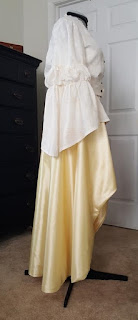My sister was born in the wee hours of the first of November. As any good sibling would do, I told her the witches brought her on Halloween. Poor Jackie! We do prepare our younger brothers and sisters for the real world, don't we? ;) Had I known then that in 2020 we would be in a worldwide pandemic with social events very limited and Halloween a much quieter affair I might have been nicer to her. But what if the witches did bring her??!!
While scrolling through Instagram one day I happened upon this post:
What fun! I wonder what they wore for Halloween 100 years ago?
My Google search led me to an Etsy seller with whom I'm very familiar and have purchased many patterns from, Mrs Depew Vintage. There was a reproduction of a 1925 booklet published by the Dennison Manufacturing Company, manufacturers of crepe paper.
Into the cart it went and I was able to view pages immediately in the pdf download.
So interesting to see the copyright date for this booklet. 1925!
The costumes are incredible and the directions easy to follow for both adult and child sizes.
The back of the booklet caught my attention and I immediately knew this was the costume I wanted to recreate. A rainbow! Exactly what I need in this seventh month of pandemic Safer At Home.
Pastel colors would be so beautiful to work with!
Crepe paper is also readily available through my online grocery order and very affordable at 97 cents for 81 feet. There are no instructions for this costume so I compare the illustration measurements to my 5'6" height and calculate the height and width of all pieces, calculate the number of feet I will need to complete the costume, and place my crepe order along with groceries needed for the week.
Crepe paper can be sewn with needle and thread and with some tulle and organza, some tissue for backing for machine sewing, some ribbon and a recycled metal headband and some millinery wire, I have everything I need to create a rainbow costume.
The skirt length is 37" for me and I calculated the overlap for each crepe paper strip to get the skirt coverage I wanted, cut the number of strips for each color, and sewed them to a strip of grosgrain ribbon.
The panniers took a bit more thought as to their size and how they would be supported, and my millinery experience came in handy here. I cut recycled pink tulle to the shape I had calculated and laid it on tissue. After some practice techniques, I folded each strip of crepe paper in half lengthwise and machine stitched two slightly overlapping layers of each color onto the tulle/tissue ending with the final center fill of lavender.
Millinery wire is sewn between the white and purple rings and extended beyond the pannier to become a support that will hook over a ribbon belt and lay against the hip. Two additional lengths of millinery wire are attached near the center of the pannier for additional support.
Panniers hooked to a ribbon belt:
The shape of the blouse is just a nice cylinder and with some more calculating I cut and sewed strips of crepe paper to organza and added some organza ribbon with floral edging.
The bodice straps have a foundation of satin ribbon with 2 strips of crepe paper sewn and folded and embellished with the same organza floral ribbon.
Now to create that fabulous hat! Again I used a scrap piece of tissue with my dimensions and color plan drawn on the tissue. Another piece of tulle will hold everything together after the sewing.
Removing the tissue:
Adding a metal headband encased in some organza ribbon:
The front is embellished in the center and over the bottom edge with the organza floral ribbon.
Humidity naturally makes the crepe paper ruffle and we have just had Hurricane Zeta blow through. I may stretch the edges of each strip just a bit more before I wear this costume but these few days are showing some fun natural texture happening.
I added some streamers and freeform flowers to the panniers to mimic the illustration and now the costume is complete!
Happy Halloween!
Historical Sew Monthly
The Challenge: October - Get Crafty
Material: Crepe Paper
Pattern: Inspired by Dennison Manufacturing Co. booklet available through Mrs. Depew Vintage on Etsy
Year: 1925
Notions: Millinery wire, ribbon, thread, organza, tulle, tissue paper
How historically accurate is it? The crepe paper manufactured at that time was similar to our heavy crepe paper. I used readily available streamer crepe paper.
Hours to complete: 22 hours
First worn: Will be worn for photos and video soon
Total cost: $12
.jpg)


































































































